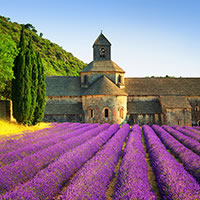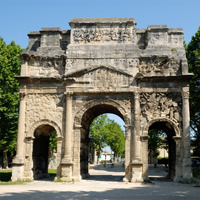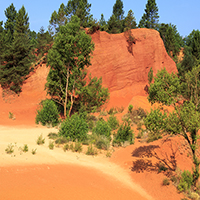THE LUBERON - ATTRACTIONS

Lavender
Lavender is all over the Luberon with concentrations located in different areas of the region. Here, you`ll find concentrations of lavender fields: on the high plateau around Sault, at the foot of Mont Ventoux, and around Apt and Gordes. Lavender in the Luberon blooms from around the end of June to the beginning of August when it is harvested. It is usually at its peak in early July.
On your way to Sault you will come to the village of Simaiane la Rotonde, this perched village is surrounded by fields of lavender at its base, an ideal spot for some beautiful pictures of the Lavender when in full bloom. And near Gordes, you`ll find the field in front of Senaque Abbey - perhaps the most famous shot in Provence for it`s lavender.
It is also popular to visit lavender farms and distilleries while visiting the Luberon. There are festivals surrounded around lavender at Sault and Valreas, and lavender products galore to buy in the area (oil, essences, perfumes, soap, etc.). And a must see museum for nature lovers and lovers of lavender is the Lavender Museum in Carieres d`Avignon. The museum will take you through a collection of lavender stills from the 16th-century to present time. This is a great place to discover the true lavender of Provence.
Lavendar Farms: La Ferme de Gerbaud, Ho! Bouquet de lavande, Les Lavandes du Gaec Champelle
Lavender Distilleries: AEC Aroma `Plantes, Distillerie les Coulets, Distillerie du Vallon, Distillerie Les Agnels

Notre-Dame de Senanque Abbey, Gordes
The Notre-Dame de Sananque Abbey located near the village of Gordes, is still a community of Cisterician Monks, since 1148. The architecture and the splendor of the valley where the Abbey is situated are magnificent. The community of monks gives you the opportunity to tour the facility each week (French only) to where you will discover the 12th-century Monsastic Buildings - the Cloisters, Church, Chapter room, and others.

Castles
The villages of the Luberon are all built around a castle or some form of defensive structure. As you explore the villages you will notice many of these structures differing in states, from a few walls to entirely preserved buildings. Some of these castles are privately owned while others are open to the public. Every one of these castles built in a dominant position of the village offering far-reaching views so invaders could be spotted.
Some of the castles of the Luberon date back to the 10th-century. In the 13th and 14th centuries, bigger castles were built (used more for residential). The most interesting chateaux of the Luberon and surrounding areas that can be visited include Lourmarin, Gordes, Lacoste, La Tour d`Aigues, Buoux, Oppede-le-vieux, St-Saturnin-les-Apt, Merindol, and Fontaine de Vaucluse.

Roman Ruins
From Roman arenas, amphitheaters, aqueducts and triumphal arches, to villas, baths, temples and lost towns, all have survived the test of time. In Arles, Caesar made a Roman colony in 46 BC and it became the crossroads for trade between Italy, Spain and Rhone, and consequently a `little Rome`. As it grew, the colony was adorned with its own amphitheaters, a basilica, a circus, triumphal arches, baths and temples. The village of Glanum also offers extraordinary sites of Roman life with a monumental area with a forum, temples, fountains, a basilica, and a theatre.
Some other impressive Roman ruins and monuments in the Luberon can be found in Nimes (The Maison Caree and Arenas of Nimes), Vaison LaRomain, and Orange.

The Ochres of the Luberon
The ochre in the Luberon is one of the most unusual attractions of the area. The ochre here is caused by iron oxide deposits in the sandy soil, which origins can be traced back millions of years when the region was under water. When the railway arrived in the area in 1877, the industry exploded. By 1929 over 44,100 tons of ochre were being extracted a year in the regions`s hundred plus underground mines and open-air quarries. Today, only a single working ochre quarry can be found in France.
Sentier des ochre is located in Roussillon village. Two circular trains (about a 40 - 50 minute walk to complete) wind through mini-desert landscapes with information panels all around to identify different types of flora to spot, the history of local ochre production, etc.
Usine d`Ocre Mathieu in Roussillon is a must see museum to better understand the industrial adventure of ochre which completely transformed the Vaucluse landscape from Roussilllon to Rustrel. The Conservatory is the former Mathieu Factory, still ochre-colored from floor to ceiling.
The ochre Mines of Bruoux are located 4.5 miles east of Roussillon and 3 miles north-west of Apt. Almost a half mile long trail has been created in a spectacular site, combining both nature and history. These impressive tunnels make an underground cathedral; an immersion into the aesthetic quality of ochre that pays tribute to the ochre diggers, both quarry men and artists.

The Luberon Markets
The Luberon offers markets every day of the week ranging from a handful of stalls, like at Oppede-le-Vieux, to the town markets at Cavaillon, and the biggest of them on Saturday mornings in Apt, with up to 300 stalls. The markets are a French ritual very popular with locals and tourists alike. Most of the villages are year-round, while some are only during the summer months. The markets add color, energy and vitality to a village.
The markets are full of choices with fruits and vegetables of all kinds and colors. You`ll find a full range of herbs and plants, goat cheeses, olive oils, honey and jams, flowers, wines, ready to eat rotisserie chickens, Provencal fabrics and house wares, clothes, and much more. The markets are usually in the morning, until lunchtime (around 12 or 1pm). You will also find evening farmers` Markets in the summer months located in certain villages through the Luberon.
Markets of the Luberon:
Monday -- Cadenet, Cavaillon, Lauris
Tuesday -- Cacuron, Gordes, Lacoste, La Tour d`Aigues, St Saturnin les Apt, Lourmarin (evening farmer`s market)
Wednesday -- Gargas, Merindol, Pertuis, St Martin de Castillon, Sault
Thursday -- Caumont, Cereste, Goult, Menerbes, Robion, Roussillon
Friday -- Lourmarin, Bonnieux

The Villages
The most popular of the attractions in the Luberon are the villages themselves. The Luberon is characterized by a series of remarkably picturesque hill-top villages, dating back thousands of years. Famous names like Gordes, Roussillon, Bonnieux, Lacoste and Menerbes can be found here, along with many beautiful villages that are rather unknown. While the hill towns can be seen as subtly different variation on the same theme, each has its own separate personality. Every village has something to offer and treasures to be discovered.
Villages in the Luberon: Ansouis, Bonniex, Buoux, Cabrieres d`Avignon, Cadenet, Caseneuve, Coustellet, Cucuron, Fontaine de Vaucluse, Gordes, Goult, Isle sur Sorgue, Joucas, Lacoste, Lagnes, Lourmarin, Maubec, Menerbes, Methamis, Murs, Oppede le Vieux, Robion, Roussillon, Saignon, St-Saturnin-les-Apt, Viens.

Wineries
Wine and vineyards of the Luberon are known all over the world. You will come across many wineries as you drive around the Luberon, to find out more about the wines, the winemakers of Luberon will welcome you on to their estates. This means you can discover the secrets of wine making by visiting the wine cellars, take part in tasting workshops, wander around the vineyards, and learn the history of wine by visiting the wine making museums.

Bories Village, Gordes
The Bories village was listed as a Historical Monument and is home to the largest collection of Bories, including sheep folds, bread ovens, wine storerooms, fences, enclosures and walls. It is a traditional heritage site that represents the Provencal countryside`s unique identity.
The huts in Bories are referred to locally as Gallic huts, built from dry stone walls, without the use of mortar, based on the architectural principle of the corbelled vault. The stones for the huts were extracted from the limestone hills and ground around Gordes and used to build farm huts. The Bories Village, restored between 1969 and 1976, stands today as it did when the last inhabitants abandoned it about 150 years ago.

Outdoor Adventures
From cycling, hiking, and mountain biking to water activities, rock climbing, tree top adventure and golf, there is so much to do when it comes to the great outdoors for adventure. The Luberon offers paths lined with vineyards, orchards, sunflowers, perched villages, castles, ochre valleys, and lavender fields. Cycling circuits and walking/hiking trails in the Luberon region of Provence offer one of the best ways to see the picturesque region.
You can also find various activities on the water from canoeing, relaxing swims in the rivers, swimming pools or lakes, kayaking or just simply relaxing with a picnic at the edge of the water. And for the more adventuresome traveler check out the Dentelles de Montmirail, Ventoux valleys, Falaises de Boux, just some of the many sites that make a great place for climbing. Or, practice your swing with a round of 18-holes of golf with a beautiful course. When it comes to being outdoors, this area offers it all.

Museums & Galleries
Carrieres de Lumieres (Quarry of Light) -- Les Baux de Provence Vast projections of the paintings of van Gogh and Gauguin
Movement and Light -- Isle sur la Sorgue Kinetic and optical sculpture
Fondation Vasarely (Varsarely Foundation) -- Aix-en-Provence Housing the vast works of the optical artists Victor Vasarely